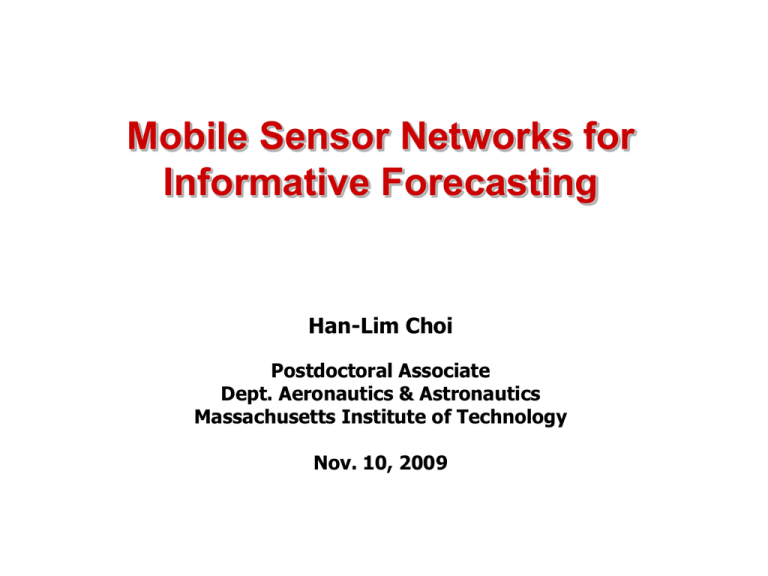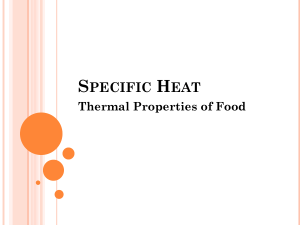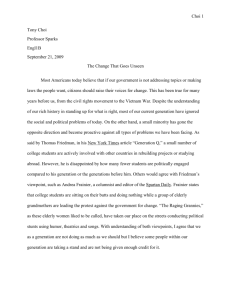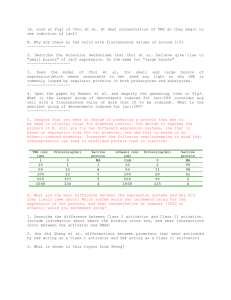Mutual Information
advertisement

Mobile Sensor Networks for Informative Forecasting Han-Lim Choi Postdoctoral Associate Dept. Aeronautics & Astronautics Massachusetts Institute of Technology Nov. 10, 2009 Research Theme: Networked Information Systems • Planning of Sensor Networks – Allocate sensing resources to extract information – Information quantification in large-scale systems – Balance between information and energy [ChoiPhD] H.-L. Choi, “Adaptive sampling and forecasting with mobile sensor networks,” PhD Thesis, MIT. • Multi-Agent Task Planning – Distributed task allocation over a network of autonomous agents – Realities in dynamic, uncertain environment – Interaction with humans [ChoiTRO09] H.-L. Choi, L. Brunet, and J. P. How, “Consensus-based decentralized auctions for robust task allocation,” IEEE Transactions of Robotics, 25(4), 2009. Introduction • Forecasting of Environmental Systems – Increasing potential damages due to adverse environmental conditions (e.g., snow storms, hurricanes) – Need accurate forecasting of future environmental conditions • Intelligent Measurement Systems – Under limited sensing and computation resources – Allocate fixed or redeployable sensors to gather information directed by particular interests Han-Lim Choi (MIT), Nov. 10 3 Introduction • This research – Theoretical framework for intelligent measurement systems for improved forecasting of large-scale systems • Applications – Weather forecasting, Plume source tracking, Wildfire tracking, Geoscientific investigation, Smart building © MIT EAPS © UC Berkeley Han-Lim Choi (MIT), Nov. 10 4 Overall Architecture • Dynamic Data-Driven Loop Closure – Use model to make measurement plans ) Plan execution ) Use collected data to update model/plans – Integration of physical environment, (mobile) sensors, numerical model of environment, planning & control algorithms Sensors Models - Environment - Sensor - Uncertainty Performance Evaluation Environment Planning Planning Data Focus on Planning – given model, make measurement plans Han-Lim Choi (MIT), Nov. 10 5 Planning Challenges • Environmental dynamics nonlinear and typically have large state dimension – E.g. weather system ~O(106) • Multi-scale dynamics – What is the right choice of time- and length-scale to make the decisions of interest? • Uncertainty in model states, parameters, and observations – Need to be able to quantify uncertainty propagation through large-scale nonlinear dynamics • Planning: Large-Scale Complex Optimization Han-Lim Choi (MIT), Nov. 10 6 Weather Forecasting • Example: Improve weather forecast by developing supplementary sensing networks with teams of Unmanned Aerial Vehicles • Related work – Targeting for crewed aircraft to localize error-sensitive or error-reducing regions [Lorenz98,Palmer98, Majumdar02, Daescu04] • High cost, high risk, less adaptability – NOAA’s Unmanned Aerial Vehicles Program (announced ’08) 4 UAV sensors for better forecast – UAV path planning with considering realistic over red squares in 3days [Rubio04, Frew09] weather conditions (e.g., icing, storm) – Development of Micro Air Vehicles for weather sensing[Lawrence07] • This work: higher level decision on where and when to take measurement using network of mobile sensors Han-Lim Choi (MIT), Nov. 10 7 Planning for Information • Design mobile sensor networks to extract best possible information – Objective: Reduce uncertainty in knowledge about some environmental quantities of interest at some time of interest (called verification variables and time) – Quantification: Define information reward of sensing path to represent uncertainty reduction – Complications: • Combinatorial decision making • Constraints in mobility, communication, power • More complicated if large state dimension and/or long verification horizon – Most previous work in the context of tracking targets (small state) • Goal: Efficient algorithms for allocation of mobile sensor networks in a large-scale complex systems for maximum information Han-Lim Choi (MIT), Nov. 10 8 Approach • Bi-level decision framework Better tractability and better accounting for multi-scale dynamics Scale of motion Long Short Decision space Discrete Continuous Problem Class Combinatorial selection Optimal control o o 72 W Informative Steering How to get there 78oW Information-rich waypoints Where to go 84 oW Objective o 60 W Motion Planning 66 W Targeting o 48 N • Mutual Information – Information-theoretic notion of uncertainty reduction – Information reward for both abstractions • Key Focus: Efficient quantification of Mutual Information Han-Lim Choi (MIT), Nov. 10 o 44 N Motion Targeting Planning o 40 N o 36 N o 32 N 9 Targeting as Sensor Selection s : measurement candidate (n) Z1 Z3 ZS V Z2 S : Search Space (N) Zn V : Verification Variables time • Objective: Select n sensing points from search space that maximize uncertainty reduction of verification variables (V ) – – : entropy of V (i.e., degree of randomness) : conditional entropy of V after knowing • Baseline formulation for problems with dynamics and constraints Han-Lim Choi (MIT), Nov. 10 10 Forward Approach s : measurement candidate (n) Z1 Z3 ZS V Z2 S : Search Space (N) Zn V : Verification Variables (M) • Explicitly compute conditional entropy for all possible measurement candidate – : same for all candidates minimize conditional entropy – Gaussian Entropy = log det of Covariance • Issues: Computational complexity – Combinatorial number of candidates (75 million for N=100, n=5) – Calculation of each conditional entropy takes non-trivial time (Covariance update, determinant calculation) Han-Lim Choi (MIT), Nov. 10 11 Key Intuition for Alternative Approach • Mutual Information – Represents entropy reduction – Commutative [Cover91]: Area = Entropy Han-Lim Choi (MIT), Nov. 10 12 Backward Approach s : measurement candidate (n) Z1 Z3 ZS V Z2 S : Search Space (N) Zn V : Verification Variables (M) • Look at entropy reduction of measurement candidate – Motivated by [Williams05] but identified new insights: • Single covariance update to compute conditional covariance of entire search space – Calculation of : submatrix extraction – Still combinatorial number of determinant calculation Han-Lim Choi (MIT), Nov. 10 13 Efficiency of Backward • Probabilistic representations – Covariance vs. Ensemble – Ensemble: typical framework for weather forecasting • Computation time comparison – Asymptotic analysis – Numerical experiments Numerical experiments: 104 103 Ensemble 102 Asymptotic analysis in flops 10 Covariance 1 • Backward approach is never slower than Forward approach • Significant benefit for ensemble representations [ChoiACC07] H.-L. Choi, J. P. How, and J. A. Hansen, “Ensemble-based adaptive targeting of mobile sensor networks,” American Control Conference, 2007. [ChoiTCST09] H.-L. Choi, and J. P. How, “Efficient targeting of sensor networks for large-scale systems,” IEEE Transactions on Control Systems Technology, submitted. Han-Lim Choi (MIT), Nov. 10 14 Summary of Targeting • Commutative mutual information backward – Provable efficiency over forward approach by reducing the number of covariance updates – Significant computational saving for ensemble-based large-scale targeting • Constrained problem can be embedded in the backward framework [ChoiGNC07] o 72 W 78oW o 60 W o 66 W 84 oW [ChoiGNC07] H.-L. Choi and J. P. How, “A mult-UAV targeting algorithm for ensemble forecast improvement,” AIAA Guidance, Navigation, and Control Conference, Aug. 2007. o 48 N o 44 N • Next: Given where to go, How to get there by maximizing information Motion Targeting Planning o 40 N o 36 N Targeting o 32 N Han-Lim Choi (MIT), Nov. 10 15 Continuous Exploration During 0 to t θ At T Forecast Verification Sensing path • Linear environmental dynamics: – State variables Xt : environmental variables at grid points – Short time-scale/local behavior of original nonlinear dynamics – Additive Gaussian process noise • Linear measurement: – Off-grid measurement = linear combination of state variables • Vehicle Motion: Han-Lim Choi (MIT), Nov. 10 16 Issues in Continuous Planning During 0 to t θ At T Forecast Verification Sensing path • Continuous abstraction – Better models environmental sensing – Better scalability than increasing resolution of discrete targeting • Issues – Less-established theory on computation of mutual information – Simple extension of previous work is computationally inefficient Han-Lim Choi (MIT), Nov. 10 17 Continuous Mutual Information • Straightforward way: – Explicitly calculate entropy of verification variables at T – Need to integrate matrix differential equations for long time interval to propagate effect of measurement into the future Computational inefficiency in optimal planning • Mutual Information by conditional independence – Once the state is known at the current time, no additional information can be obtained from the past in order to predict some future quantity – Difference in mutual information between before and after knowing Han-Lim Choi (MIT), Nov. 10 and 18 Smoother Form • Smoother form mutual information – – – : inverse covariance of state (Lyapunov) : inverse covariance of state conditioned on V (Lyapunov-like) : covariance of state conditioned on measurement (Riccati) • In planning, integration of matrix differential equation during Computation time reduction by factor of • On-the-fly track of information accumulation at arbitrary time t Expression of rate of information accumulation [Choi08cdc & Choi09auto] [ChoiCDC08] H.-L. Choi and J. P. How, “Continuous motion planning for information forecast,” IEEE Conference on Decision and Control, Dec. 2008. [ChoiAuto09] H.-L. Choi and J. P. How, “Continuous trajectory planning of mobile sensors for informative forecasting,” Automatica, submitted. Han-Lim Choi (MIT), Nov. 10 19 Information Potential Field • Distribution of information based on rate of information accumulation – Instantaneous information increment when taking measurement at location (x,y) at time t • Variation by design objectives Minimize uncertainty in V at T Han-Lim Choi (MIT), Nov. 10 Minimize uncertainty in current state 20 Summary • Conditional Independence Smoother Form – Computational efficiency by reducing interval of integration of matrix differential equations – On-the-fly access to information accumulation Legitimate information potential field – More insights in broader class of planning problem [ChoiACC09] [ChoiACC09] H.-L. Choi and J. P. How, “On the roles of smoothing in planning informative paths,” American Control Conference, June 2009. • Key Contributions: – Efficient quantification of information reward: Backward and Smoother – Information-theoretic planning of mobile sensor networks in the context of weather forecasting Guideline for tractable design of measurement systems for multi-scale complex nonlinear systems Han-Lim Choi (MIT), Nov. 10 21 Future Research • Long-term goal: Innovations in Robotics and Control towards Ubiquitous Intelligent & Sustainable Living Environment • Information-driven decision making (for cyber-physical systems) – Sensor/actuator networks for large-scale systems • Richer class of uncertainties and constraints – Enrich notions of information • How to define information in constrained space • How to incorporate notions like risk & safety Indoor aerial robots – Navigation and control of autonomous robots – Uncertainty quantification & Design of experiments for complex systems – Funding sources • NSF cyber-physical systems, NSF cyber-enabled discovery & innovation – Related on-going work • Planning for mobile sensor networks with model uncertainty • Sensor management under limited communication budget [ChoiACC08] [ChoiACC08] H.-L. Choi, J. P. How, and P. I. Barton, “An outer-approximation algorithm for generalized maximum entropy sampling,” American Control Conference, June 2008. Han-Lim Choi (MIT), Nov. 10 22 Future Research • Networked (semi)-autonomous vehicles – Distributed decision making • Robustness in dynamic, uncertain environments • Multi-agent learning & information fusion – Interaction of humans and autonomy – Fundamental theories of networks Cooperative UxV missions • Information flow in heterogeneous networks – Funding sources • AFOSR, ONR, ARO, NSF Network science & engineering – Related on-going work • Distributed task allocation algorithm for network of agents robust to inconsistent situational awareness • Its extensions to handle: complex missions [Choi10acc, Ponda10acc], uncertainty [Bertuccelli09gnc, Redding10acc], human-autonomy interaction [Ponda10info] • Distributed decisions for sensor networks [Choi07gnc] Human-robot interactions ©UMBC eBiquity Research Group Social network Han-Lim Choi (MIT), Nov. 10 23 Future Research • New Applications (in Aerospace, Energy, Environment) – – – – Geosciences, Weather, Climate Air traffic management Smart building, Water resource Smart grid, Sustainable energy • Collaborations – Center for automation technologies and systems – Multi-scale science and engineering – Scientific computation research center Networked wind turbines Han-Lim Choi (MIT), Nov. 10 Networked electricity grid Air traffic management Building emergency Underwater mixing 24 Educational Synergy • Education Philosophy – Encourage inter-disciplinary thinking – Engineering insights & Mathematical foundation • why do we care about this • how can we solve it ©RPI Center for Innovation in Undergraduate Education • Educational impacts – Graduate research – Undergraduate research • Modeling/analysis/optimization of a variety of systems • Hands-on experiments with multi-robot testbeds – Existing curriculum • Enrich description of system dynamics – Curriculum development • Senior: Introduction to high-level control & autonomy • Graduate: Decision making under uncertainty Han-Lim Choi (MIT), Nov. 10 25 Acknowledgment • NSF Dynamic Data Driven Application System • AFOSR, ONR, Boeing • Collaborators: – – – – – – – Prof. Jonathan P. How (MIT Aero/Astro) Prof. Nicholas Roy (MIT Aero/Astro) Dr. James A. Hansen (Naval Research Laboratory) Prof. Paul I. Barton (MIT ChemE) Prof. Emilio Frazzoli (MIT Aero/Astro) Sooho Park, Daniel Gombos (MIT DDDAS) Luca Bertuccelli, Luc Brunet, Cameron Fraser, Sameera Ponda, Andrew Whitten, Josh Redding (MIT ACL) Han-Lim Choi (MIT), Nov. 10 26 References • [Lorenz98] E. Lorenz and K. Emanuel, “Optimal sites for supplementary weather observations: simulation with a small model,” Journal of the Atmospheric Sciences, 55(3), pp. 399-414. • [Parmer98] T. Palmer, R. Celaro, J. Barkmeijer, and R. Buizza, “Singular vectors, metrics, and adaptive observations,” Journal of the Atmospheric Sciences, 55(4), pp. 633-653. • [Majumdar02] S. Majumdar, C. Bishop, B. Etherton, and Z. Toth, “Adaptive sampling with the ensemble transform Kalman filter. Part II: Filed programming implementation,” Monthly Weather Review, 130(3), pp. 1356-1369. • [Daescu04] D. Daescu and I. Navon, “Adaptive observations in the context of 4D-var data assimilation,” Meteorology and Atmospheric Physics, 85(111), pp. 205-226. • [Williams05] J. Williams, J. Fisher III, and A. Willsky, “An approximate dynamic programming approach to a communication constrained sensor management,” Int’l conf. of Information Fusion, 2005. • [Cover91] T. Cover and J. Thomas, Elements of Information Theory. Wiley Series In Telecommunications, 1991. • [Rubio04] J.C. Rubio, J. Vagners, R. Rysdyk, “Adaptive path planning for autonomous UAV oceanic search missions,” AIAA Intelligent Systems Technical Conference, 2004. • [Frew09] J. Elston, E. W. Frew, “Unmanned Aircraft Guidance for Penetration of Pre-Tornadic Storms,” AIAA Journal of Guidance, Control, and Dynamics, 2009. • [ChoiACC10] H.-L. Choi, A.K. Whitten, and J.P. How, "Decentralized task allocation for heterogeneous teams with coordination constraints," American Control Conference, Baltimore, MD, USA, July 2010, submitted. • [PondaInfo10] S. Ponda, H.-L. Choi, and J.P. How, "Predictive planning for heterogeneous teams with human agents," AIAA Infotech@Aerospace, Atlanta, GA, USA, Apr. 2010, submitted. • [PondaACC10] S. Ponda, J. Redding, H.-L. Choi, J.P. How, B. Bethke, M. A. Vavrina, and J. Vian, "Distributed task planning for complex missions with communication constraints,"American Control Conference, Baltimore, MD, USA, July 2010, submitted. • [ReddingACC10] J. Redding, H.-L. Choi, and J.P. How, "An intelligent cooperative control architecture,"American Control Conference, Baltimore, MD, USA, July 2010, submitted. • [ChoiTRO09] H.-L. Choi, L. Brunet, and J.P. How, "Consensus-based decentralized auctions for robust task allocation," IEEE Trans. on Robotics, , Vol. 25, No. 4, pp. 912 - 926, 2009 • [ChoiAuto09] H.-L. Choi and J.P. How, "Continuous trajectory planning of mobile sensors for informative forecasting,"Automatica, submitted • [ChoiTCST09] H.-L. Choi and J.P. How, "Information-theoretic targeting of sensor networks for large-scale systems," IEEE Trans. on Control Systems Technology, submitted • [ChoiACC09] H.-L. Choi and J.P. How, "On the roles of smoothing in informative path planning," American Control Conference, St.Loius, MO, USA, June 2009, submitted. • [ChoiCDC08] H.-L. Choi and J.P. How, "Continuous motion planning for information forecast," IEEE Conference on Decision and Control, Cancun, Mexico, Dec. 2008. • [ChoiACC07] H.-L. Choi, J.P. How, and J.A. Hansen, "Ensemble-based adaptive targeting of mobile sensor networks," American Control Conference 2007, New York City, NY, USA, July 2007. • [ChoiGNC07] H.-L. Choi and J.P. How, "A multi-UAV targeting algorithm for ensemble forecast improvement," AIAA Guidance, Navigation, and Control Conference 2007, Hilton Head, SC, USA, Aug. 2007, AIAA-2007-6753. • [ChoiACC08] H.-L. Choi, J.P. How, and P.I. Barton "An outer-approximation algorithm for generalized maximum entropy sampling," American Control Conference 2008, Seattle, WA, USA, June 2008 Han-Lim Choi (MIT), Nov. 10 Han-Lim Choi (MIT), Nov. 10 Probabilistic Representations • Covariance Form – Mean and covariance – Conditional distribution: Update covariance (Kalman Filter[Grewel01]) • Ensemble Form – Monte-Carlo samples (a total of LE ) – Covariance is approximated as sample covariance – Conditional distribution: Update each sample (Ensemble SquareRoot Filter[Whitaker01]) – Preferred for estimation of large-scale nonlinear systems Comparison of efficiency of backward approach in these two forms Han-Lim Choi (MIT), Nov. 10 29 Motion Planning Results Strategy Reward Optimal minimizing 0.69 uncertainty in V at T Gradient-ascent in 0.62 potential field Minimize uncertainty 0.20 in X at Minimize uncertainty 0.14 in current X Best Straight-line 0.43 Worst Straight 0.14 Type OCP Closed OCP Closed NLP NLP • Goal: 6-hr sensing trajectory to reduce uncertainty over in 3 days • Optimal Control Problem solution by NLP reformulation (<2mins per initial guess) • Reasonable performance of gradient-ascent • Potential performance degradation in decisions based on short-term perspectives Han-Lim Choi (MIT), Nov. 10 32 Probability of Correct Decision (PCD) • PCD = Prob [ Correctly distinguish the best candidate from a total of q candidates] = PCD (RNR, q) – Expressed as CDF of (q-1)-dimensional multivariate normal distribution • ε-PCD = Prob [ Better than (1- ε)-optimal solution obtained ] ≈ PCD (RNR, 1/ε) – Useful for large-scale targeting with very large q • Useful quantification: – Required RNR to achieve given level of optimality with a certain surety • RNR=16.5 for 90% optimality with 90% confidence – Achievable level of Optimality for given RNR with a certain surety • 75% optimality guaranteed for RNR=6 with 90% confidence Han-Lim Choi (MIT), Nov. 10 Confidence






